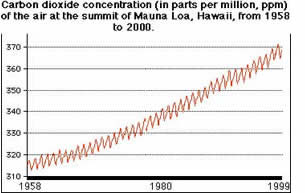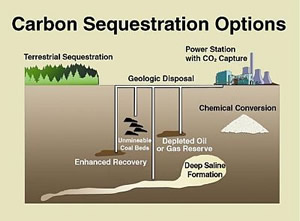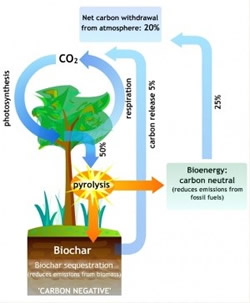The Carbon Cycle— The movement of carbon, in its many forms, between the biosphere, atmosphere, oceans and Earth's crust is called the carbon cycle. Plants absorb carbon dioxide (CO2) from the atmosphere during photosynthesis and release oxygen (O2) during respiration. Animals breathe in O2 and breathe out CO2. All organisms release carbon and CO2 during decomposition or burning. This active carbon cycle, with CO2 being released into the atmosphere and reabsorbed by plants and oceans, has been balanced for millennia.
So What's Causing the Climate to Change?— Simply, Earth's atmospheric CO2 is out of balance. Scientists know that Earth's climate has changed cyclically over millions of years. However, never in geologic history has it changed so dramatically, so fast. The spike in global warming —and atmospheric CO2— coincides with the Industrial Revolution when fossil fuels began to be widely used. Fossil fuels originated from plants and animals. Just like plants today, this ancient biomass contains a lot of carbon but it's been sequestered in the ground in the inactive carbon cycle.
Burning fossil fuels combines oxygen with that carbon, which creates an abundance of CO2. Excess CO2causes the greenhouse effect, trapping the sun's heat. Other gases, like methane and nitrous oxide, exacerbate the greenhouse effect.
 The active carbon cycle is being overwhelmed with much more CO2 than it can handle from the release of carbon from the inactive carbon cycle. Because biochar has the ability to capture some of the carbon from the active cycle and return it to the inactive cycle, biochar has the potential to reduce atmospheric CO2 levels.
The active carbon cycle is being overwhelmed with much more CO2 than it can handle from the release of carbon from the inactive carbon cycle. Because biochar has the ability to capture some of the carbon from the active cycle and return it to the inactive cycle, biochar has the potential to reduce atmospheric CO2 levels.
CO2 Sequestration— As described in the carbon cycle, carbon is always on the move. Living organisms exchange CO2 regularly with the atmosphere. Forest fires and volcanic eruptions belch CO2into the air. But trees, plants, algae, the oceans, soils and fossil fuels are all carbon sinks or sponges. this natural carbon sequestration has been happening for billions of years. These sinks release carbon at different rates and times.
 Humans are racing to find ways to artificially sequester carbon, primarily by pumping captured industrial CO2 back into the ground. This emerging and costly technology has potential but will take years to perfect. In the meantime, increasing the rate of natural sequestration and reducing emissions of greenhouse gases remains critical. Biochar technology can do both.
Humans are racing to find ways to artificially sequester carbon, primarily by pumping captured industrial CO2 back into the ground. This emerging and costly technology has potential but will take years to perfect. In the meantime, increasing the rate of natural sequestration and reducing emissions of greenhouse gases remains critical. Biochar technology can do both.
Integrated Solution Strategy— Biochar and clean energy (heat and power) can be produced by pyrolysis (super-heating biomass in closed system-ovens). This alternative energy reduces greenhouse gases by offsetting fossil fuel use, and since all emissions are captured, doesn't emit more. So to produce both biochar and renewable energy is a carbon neutral process as it neither adds to the climate change problem nor reverses it.
 When creating biochar, 50% of the original carbon in the biomass is captured and stored in the char. Human experimentation thousands of years ago revealed that biochar is a great soil amendment, increasing the productivity of most soils (thereby enhancing plant growth which absorbs more CO2). Now we realize, when added to soil, biochar also captures and stores carbon that otherwise would oxidize and return to the atmosphere as CO2.
When creating biochar, 50% of the original carbon in the biomass is captured and stored in the char. Human experimentation thousands of years ago revealed that biochar is a great soil amendment, increasing the productivity of most soils (thereby enhancing plant growth which absorbs more CO2). Now we realize, when added to soil, biochar also captures and stores carbon that otherwise would oxidize and return to the atmosphere as CO2.
Biochar-amended soils also provide a 50-80% reduction in nitrous oxide emissions. Nitrous Oxide released from certain fertilizers is a more potent greenhouse gas with 310 times more impact than an equal amount of CO2.
Biochar is Carbon Negative— Biochar reverses the fossil fuel deposition of CO2 in the atmosphere by removing carbon from the active cycle and sequestering it in the inactive carbon cycle. This process not only enhances soil fertility, it displaces much of the need for fossil fuel-based fertilizers, thereby making the biochar process carbon negative — as long as biomass production is managed in a sustainable manner.
Click here for a printer friendly version.